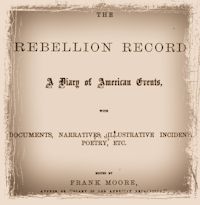June 19.—A committee from the planters of Louisiana, made a formal application to the President of the United States, for readmission into the Union.—(Doc. 75.)
—General Gregg, with his cavalry, met the rebel line of skirmishers in a piece of wood a short distance west of Middleburgh, Va., and forced them back about five miles on the road leading to Ashby’s Gap, where the enemy had two brigades of infantry. Artillery was used occasionally on both sides, but most of the time the fight was more of an Indian warfare than any thing else. Nearly all the charges made were in woods where the enemy fought from behind trees, stone walls and natural rifle-pits. A large number of the Nationals were dismounted, and they proved themselves to be quite as great adepts in the Indian style of warfare as the enemy. As the latter were driven out of one piece of timber, they would retreat into another, and thus the contest was kept up, from early morning until four o’clock p.m., almost without intermission.
During the early portion of the day the brigade commanded by Colonel Gregg was alone engaged. During the day, General Kilpatrick’s command came up, and, at a late hour, the regular cavalry, which had been sent up the Snicker’s Gap road, made a sudden dash upon the left flank of the rebels, creating quite a panic. As the regulars passed up the Snicker’s Gap pike, a squadron of the First cavalry was placed to guard the bridge across Goose Creek. The main column had been gone only a short time, when the guard was attacked by a superior force, and driven away, when the bridge was set on fire. The First Maine, Tenth, Second, and Fourth New-York, Fourth and Sixteenth Pennsylvania did most of the skirmishing. The First Maine made five charges under the most unfavorable circumstances, and added new laurels to their fame. The National loss in killed and wounded, yesterday and to-day, will probably not exceed fifty, and of the whole number there are not half a dozen wounds of a serious character. On the other hand, at the close of the day, there were thirty of the enemy’s dead and wounded at the hospital, a majority of the wounds being of a serious character. Some forty prisoners were captured, including six officers, a lieutenant-colonel, a major, a captain and three lieutenants. When the Tenth New-York entered Middleburgh yesterday, they found five of the missing First Rhode Island troopers locked up in a store, their captors not having an opportunity even to parole or carry them off, so sudden was the charge into the town made.
—The rebels at Williamsport carried all their stores to the north side of the Potomac River, with the purpose of making that their base of operations for raids into Pennsylvania.—Boonsboro, Md., was evacuated by the rebels, who carried off a number of horses and some other property.—The Seventy-fourth and Sixty-fifth regiments of New-York militia, left Buffalo, for Harrisburgh, Pa.—Two members of the staff of General Hooker, Major Sterling and Captain Fisher, were captured by guerrillas near Fairfax, Va.—Horatio Seymour, Governor of New York, issued an order organizing the National Guard of the State.—The Fifty-sixth and Fifth regiments of New-York militia, left home for Harrisburgh, Pa.—The ship Conrad, was captured by the privateer Alabama.
—A detachment of Jenkins’s rebel force on their retreat from Chambersburgh, entered McConnellsburgh, Pa., surprising the citizens and capturing a large number of horses and cattle, besides helping themselves to such provisions and wearing apparel as they could find in the stores. After thoroughly rifling the town, they left, taking the road to Hancock, Maryland.— The brig Isabella Thompson, having on board a cargo of turpentine and cotton, was captured by the Union gunboat United States, commanded by R. W. Mead, Jr.—The British schooner Glenn, of Yarmouth, N. S., from Matamoras for Nassau, being six hundred miles out of her course, was overhauled by the National steamer Cumbria, and her papers not being satisfactory, a prize crew was put on board, and she was ordered to New York.



